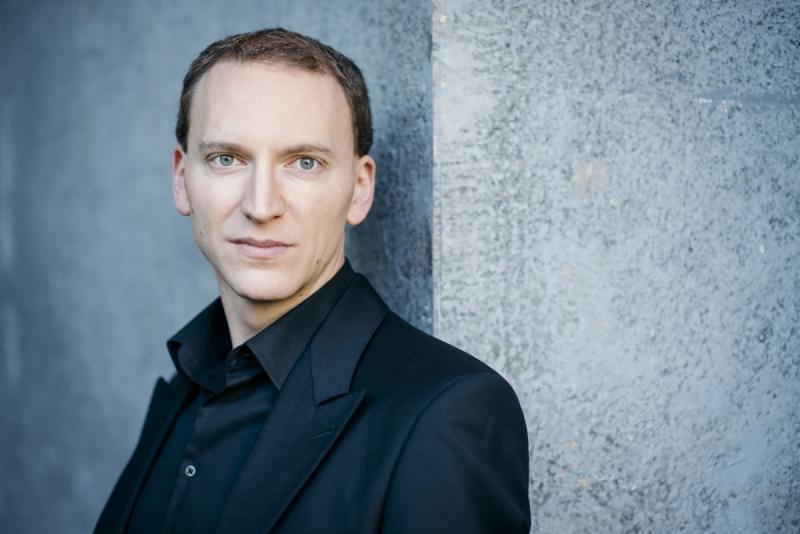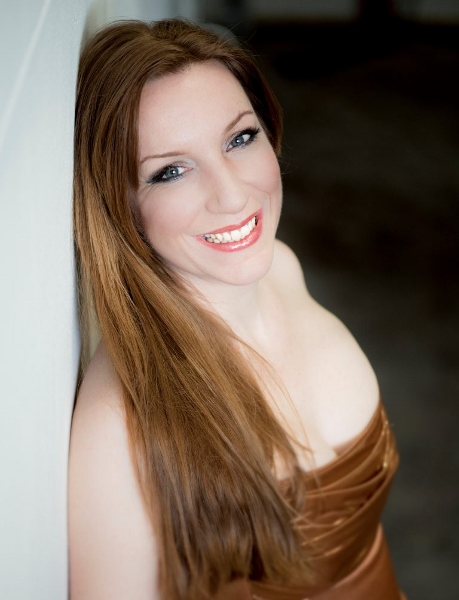Oelze, Oakes, Gould, BBC Philharmonic, Gnann, Bridgewater Hall, Manchester review - trio of surprises | reviews, news & interviews
Oelze, Oakes, Gould, BBC Philharmonic, Gnann, Bridgewater Hall, Manchester review - trio of surprises
Oelze, Oakes, Gould, BBC Philharmonic, Gnann, Bridgewater Hall, Manchester review - trio of surprises
New conductor, new soloists, new programme – and a fascinating New World Symphony

Best laid plans and all that … this concert was originally to have been conducted by the late Oliver Knussen, and of course things had to change after his death. In the end the more recently advertised Ryan Wigglesworth was unable to conduct either, and Moritz Gnann stepped in: he first appeared with the BBC Philharmonic in 2017 and last visited in November.
Knussen’s own Flourish with Fireworks was kept as the four-minute opener, as was Henze’s Ariosi, but the premiere of a new piece by Martin Suckling fell by the wayside. Claire Booth was also unable to appear as soloist, and Christiane Oelze sang in the Henze, while Allison Oakes appeared in Berg’s Three Fragments from Wozzeck: considering her reputation and track record as a major dramatic soprano in Germany, Budapest and New York, this was something of a revelation for us, as she made her UK debut only last October (with the Bournemouth Symphony Orchestra). Of the original line-up, only Clio Gould, as violin soloist in the Henze, remained.
Gnann is a man of many sympathies, and he presented Knussen’s work – itself a kind of tribute to Stravinsky – with swagger, a sense of the exotic and an impressive build-up of rhythmic power. It was a tribute in its way to the memory of Oliver Knussen, whose father was a Hallé double bassist at one point and who was himself a familiar figure on the podium in Manchester.
Henze’s piece – whose five sections include three settings of poems by Torquato Tasso – is also quite a virtuoso work for large orchestra, and Gnann’s control of its wide sonic canvas, allied to the contributions of the soloists (both Christiane Oelze’s and Clio Gould’s, and eloquent ones from within the orchestra), was masterly. There was palpable anguish in the lamenting, finally peaceful, second movement, and a real outburst in the fourth, as Midori Sugiyama led the orchestra. And while Oelze’s singing was at its most passionate in the short central poem, it was the despair and agony expressed in the accompaniment of the final sonnet that hung in the air.
 Berg’s Fragments gave Allison Oakes (pictured right) the chance to use her skills as an actress as well as a singer: she was in character from the start, as the new mum Marie sings to her baby and watches for soldiers marching by. Oakes has taken the role in the complete opera, so she knows what Marie is thinking in this extracted scena, and her portrayal came to life in concert, while the rich power of her voice was evident by the climax of it, too. Gnann obtained eloquent playing from the orchestra in the final section.
Berg’s Fragments gave Allison Oakes (pictured right) the chance to use her skills as an actress as well as a singer: she was in character from the start, as the new mum Marie sings to her baby and watches for soldiers marching by. Oakes has taken the role in the complete opera, so she knows what Marie is thinking in this extracted scena, and her portrayal came to life in concert, while the rich power of her voice was evident by the climax of it, too. Gnann obtained eloquent playing from the orchestra in the final section.
The Dvořák symphony was a different task for all concerned – it’s a repertoire work, familiar to the players and many, one would think, of the audience. Here Moritz Gnann had fresh ideas to offer. He found drama in its opening (very slow indeed) and then hurled us into a brashly American allegro first subject, itself contrasting nicely with a charmingly nuanced Bohemian second. He likes to let everyone hear the counterpoints in the scoring wherever possible: that can be great fun, but there were times when the brass playing became a bit overly competitive.
His reading of the slow movement gave its middle section much more passion and impact than is often the case – and its final bars were beautiful and thoughtful (and earned some spontaneous applause for the movement in its own right).
The scherzo opened and closed at a fine lick, easing in the lilting trio, and the finale brought committed playing from start to finish, with exemplary clarity in the textures. It was a demonstration of what a conductor on top of his game can do with a warhorse – incidentally the same symphony that was conducted by Gianandrea Noseda the first time he appeared with the Philharmonic… and look what that debut led to.
rating
Explore topics
Share this article
The future of Arts Journalism
You can stop theartsdesk.com closing!
We urgently need financing to survive. Our fundraising drive has thus far raised £49,000 but we need to reach £100,000 or we will be forced to close. Please contribute here: https://gofund.me/c3f6033d
And if you can forward this information to anyone who might assist, we’d be grateful.

Subscribe to theartsdesk.com
Thank you for continuing to read our work on theartsdesk.com. For unlimited access to every article in its entirety, including our archive of more than 15,000 pieces, we're asking for £5 per month or £40 per year. We feel it's a very good deal, and hope you do too.
To take a subscription now simply click here.
And if you're looking for that extra gift for a friend or family member, why not treat them to a theartsdesk.com gift subscription?
more Classical music
 Kempf, Brno Philharmonic, Davies, Bridgewater Hall, Manchester review - European tradition meets American jazz
Bouncing Czechs enjoy their Gershwin and Brubeck alongside Janáček and Dvořák
Kempf, Brno Philharmonic, Davies, Bridgewater Hall, Manchester review - European tradition meets American jazz
Bouncing Czechs enjoy their Gershwin and Brubeck alongside Janáček and Dvořák
 Solomon, OAE, Butt, QEH review - daft Biblical whitewashing with great choruses
Even a top soprano and mezzo can’t make this Handel paean wholly convincing
Solomon, OAE, Butt, QEH review - daft Biblical whitewashing with great choruses
Even a top soprano and mezzo can’t make this Handel paean wholly convincing
 Two-Piano Gala, Kings Place review - shining constellations
London Piano Festival curators and illustrious friends entertain and enlighten
Two-Piano Gala, Kings Place review - shining constellations
London Piano Festival curators and illustrious friends entertain and enlighten
 Echo Vocal Ensemble, Latto, Union Chapel review - eclectic choral programme garlanded with dance
Beautiful singing at the heart of an imaginative and stylistically varied concert
Echo Vocal Ensemble, Latto, Union Chapel review - eclectic choral programme garlanded with dance
Beautiful singing at the heart of an imaginative and stylistically varied concert
 Scott, Irish Baroque Orchestra, Whelan, RIAM, Dublin review - towards a Mozart masterpiece
Characteristic joy and enlightenment from this team, but a valveless horn brings problems
Scott, Irish Baroque Orchestra, Whelan, RIAM, Dublin review - towards a Mozart masterpiece
Characteristic joy and enlightenment from this team, but a valveless horn brings problems
 Classical CDs: Voice flutes, flugelhorns and froth
Baroque sonatas, English orchestral music and an emotionally-charged vocal recital
Classical CDs: Voice flutes, flugelhorns and froth
Baroque sonatas, English orchestral music and an emotionally-charged vocal recital
 Kanneh-Mason, Britten Sinfonia, Shave, Milton Court - a grin and a big beaming smile
A pair of striking contemporary pieces alongside two old favourites
Kanneh-Mason, Britten Sinfonia, Shave, Milton Court - a grin and a big beaming smile
A pair of striking contemporary pieces alongside two old favourites
 theartsdesk at the New Ross Piano Festival - Finghin Collins’ musical rainbow
From revelatory Bach played with astounding maturity by a 22 year old to four-hand jazz
theartsdesk at the New Ross Piano Festival - Finghin Collins’ musical rainbow
From revelatory Bach played with astounding maturity by a 22 year old to four-hand jazz
 First Person: Manchester Camerata's Head of Artistic Planning Clara Marshall Cawley on questioning the status quo
Five days of free events with all sorts of audiences around Manchester starts tomorrow
First Person: Manchester Camerata's Head of Artistic Planning Clara Marshall Cawley on questioning the status quo
Five days of free events with all sorts of audiences around Manchester starts tomorrow
 Goldscheider, Brother Tree Sound, Kings Place review - music of hope from a young composer
Unusual combination of horn, strings and electronics makes for some intriguing listening
Goldscheider, Brother Tree Sound, Kings Place review - music of hope from a young composer
Unusual combination of horn, strings and electronics makes for some intriguing listening

Add comment